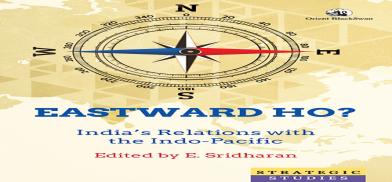Act East: A very long haul for India
Experts underline that the Act East policy can succeed only when India builds bridges with its immediate neighbors to play a constructive role in the evolving pan-Asian security architecture

India may have finally extended its diplomatic arms all across the sprawling Indo-Pacific region after breaking out of its South Asia cage, but it faces formidable challenges. Even as New Delhi changes gears by transforming its ‘Look East’ to a more pro-active ‘Act East’ policy, in almost every country, from its immediate vicinity to all the way to Indonesia and the Philippines, India faces a literal Great Wall of China – politically, militarily and economically.
As the US stock slides even among its traditional allies, Asian economic integration and China’s awesome rise have become inter-related, triggering both opportunities and problems. Experts in this scholarly volume, which no policymaker should ignore, make it clear that China, unlike the erstwhile Soviet Union, will be impossible to isolate given its huge trading strength vis-à-vis the US and almost all of Asia. And there is nothing the US can do for India in the event of a war with China, which has the ability to control the headwaters of the Indus and Brahmaputra and, if needed, divert them.
Besides its clandestine nuclear and missile partnership with Pakistan, China enjoys the advantage of terrain, infrastructure and superior forces along the Indian border. So, there are limits to how far India can sail with the US – it also explains Prime Minister Narendra Modi’s muted response to Chinese border provocations.
China’s soaring investments and checkbook diplomacy have brought it enormous power and influence, thanks to its USD 3.1 trillion foreign exchange reserves and over USD 4.6-trillion-plus annual foreign trade. From once being persona non grata and then on the margins of Asia, China has moved to the very center of Asia’s growth story. Unless we know this, it will be near impossible to understand India’s predicaments.
Vietnam, Philippines, Malaysia, Indonesia
The India-Vietnam story is a perfect example of how two countries with deep strategic and political linkages remain wary of China. Vietnam views India as a natural ally and is keen on strengthening naval cooperation with it; they have a strong military partnership. Vietnam, with a 3,300 km coastline, is one of five countries with disputes over the South China Sea.
Although anti-Chinese sentiment manifests frequently, Vietnam relies on Chinese investment and imports. Trade with China is a primary engine of Vietnam’s economic growth. Neither India nor Vietnam want an open conflict with China or even provoke Beijing. Neither wants to take sides in the other’s disputes with China. While assisting Vietnam, India will go only so far as to ensure that it does not sour its own relations with Beijing.
The Philippines too has serious differences with China over the South China Sea but this has not led to India taking up a larger space in the archipelago. Relations between Manila and New Delhi are relatively unexplored and reflect a lack of informed knowledge about one another. The engagement must be continuous on key strategic issues. Indian business presence is limited mainly in the IT and BPO sectors. While India is slow in decision-making (a complaint of many countries), China is swift and proactive in initiating multilateral initiatives. And with India’s GDP less than one-fourth of China’s in 2018, it has no capacity to get seriously involved in the South China Sea row. India’s total trade with the Philippines is one of the lowest in the ASEAN
Indonesia is India’s second-largest trading partner bilaterally in the region. But trade relations are at a muted level while there are hardly any strategic ties. However, Indonesia has come a long way since it backed Pakistan during the 1965 war with India.
In contrast, Malaysia sided with India both in the 1962 war with China and the 1965 war, but relations with New Delhi nosedived when Mahathir Mohammad was in power. Although the situation has since improved, Malaysia would not like to be too close to China or India; the Malaysian private sector prefers China, its largest trade partner. Malaysia too does not want any open conflict with China.
Thailand, Singapore, Myanmar
If the Chinese diaspora controls 11 percent of the Filipino economy, then 44 percent of Thai businesses are owned by the Chinese. Like the Filipinos, Thais too complain that Indians don’t integrate with the locals. But the Chinese have integrated seamlessly into Thai society. Thailand too is not ready to upset China although it has built several dams on the Mekong, impacting the flow of water into riparian countries. India must know that without Thailand as a partner, its position as a dominant power in the Indian Ocean may be compromised.
India’s abiding relationship with Singapore along with Vietnam constitutes the major aspect of its Look East policy. India-Singapore ties continue to sustain India’s engagements with the Asia-Pacific and Indo-Pacific that are now shaping its maritime signatures in the region. But the lack of transparency of Chinese intentions and the inability of India and the US to fathom the strategic implications are major dilemmas. Singapore is one country that has been synchronizing its strategy in envisioning a dynamic Indo-Pacific vision that is derivative of the new realities of the realigning economic and security architectures.
India-Myanmar ties saw many ups and downs before Delhi realized it cannot sail on both boats – support the pro-democracy movement and also the military junta -- at the same time. Despite a sense of dislike for the Chinese, China’s economic clout is rather high in Myanmar.
While Myanmar has sought to increase security relations with India, New Delhi needs to view seriously the building of roads and infrastructure by China in the country to protect its own security interests. The continued instability in India’s northeast derails its development as a gateway to Myanmar.
Nepal, Japan, Koreas,
China is challenging India’s position in the Himalayas and has found Nepal a willing partner. Today, many Chinese are engaged in economic activity in Nepal; many own restaurants in Kathmandu and the Pokhara Valley. Nepal has waived the visa fee for Chinese nationals and made the yuan convertible for tourists and businesspeople.
Beijing emphasizes its Buddhist linkages with Nepal, promotes Mandarin in schools by funding teachers’ salaries, and is setting up China Study Centres – which India sees as intelligence gathering hubs. India is unlikely to regain its original status in Nepal.
Diplomatic relations with Bangladesh may be good now but India is losing out to China over trade and investment; the onus is on India to deliver on some of its promises.
The North Korea-Pakistan-China nuclear trade nexus ignited strategic cooperation between New Delhi and Seoul. While South Korea has gone to great lengths to discover historical linkages between the two countries, India has been slow in its response. Even a slight push from India towards building trust with South Korea will boost its relationship. While bilateral trade figures are not encouraging, South Korean companies have succeeded in India despite the bureaucratic hurdles.
It was the collapse of the Soviet Union and the simultaneous rise of China that made India launch its Look East policy, whose heart is occupied by Japan. But despite their visible bonhomie, key differences persist. Japan wants India to openly back its claims in the South China Sea, which India cannot afford to do. Japanese trade with, and FDI in, India are simply no match even to that of Southeast Asia in terms of value and volume.
India and Japan will have to tide over the indifference between them vis-à-vis each other’s immediate security environment if they need to cement their ties. Experts underline that the Act East policy can succeed only when India builds bridges with its immediate neighbors to play a constructive role in the evolving pan-Asian security architecture. Will China let that happen?
(Eastward Ho? India’s Relations with the Indo-Pacific; Editor E. Sridharan: Publishers Orient BlackSwan; Pages 487; Price Rs 1,650)
(The reviewer is a New Delhi-based veteran journalist who writes on diplomacy and politics. He can be contacted at ranjini17@hotmail.com)










Post a Comment